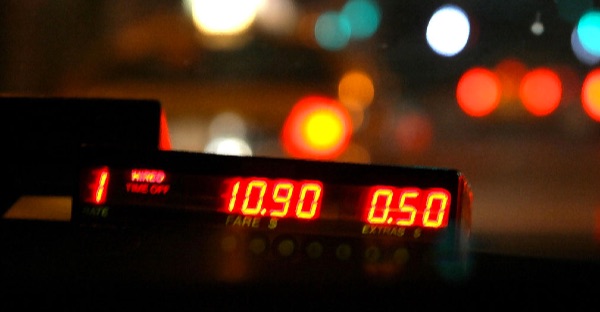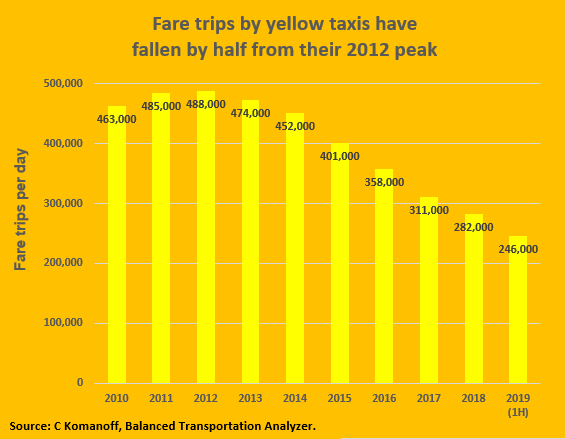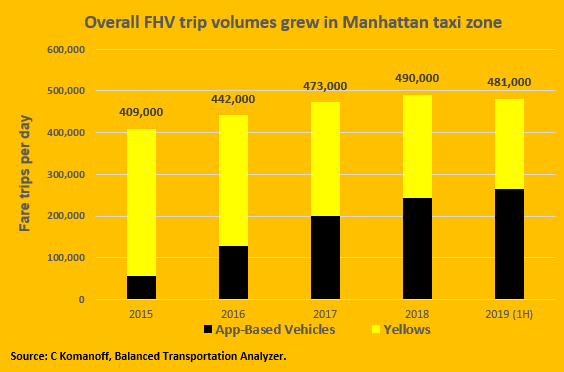Mayor de Blasio never uttered the words “Uber,” “ride-hail” or “competition” in his remarks on Tuesday announcing a $65-million Taxi Medallion Owner Relief Fund to help financially embattled medallion owners renegotiate unserviceable loans.
Brian Rosenthal of the New York Times wrote them into his coverage, which heralded the fund as the first “concrete plan to aid the drivers.” But these were cover-your-ass mentions, a sidelight to what he and the Times decreed two years ago to be the principal reason those loans were unaffordable: “a group of taxi industry leaders ... artificially inflated the price of a medallion to more than $1 million from about $200,000 [and] channeled immigrant drivers into loans they could not afford.”
But even the Paper of Record and its star reporter acknowledged that “competition from Uber, Lyft and other companies has reduced the amount of revenue that cabdrivers can make by driving.”
Has reduced? How about slashed.
By 2019, the last pre-pandemic year, fare trips by yellow taxis had fallen by half from their 2012 peak (see graphic, right). The cause, of course, was the unrestrained incursion of app-based, ride-hail companies Uber and Lyft into the Manhattan taxi zone that historically had been the exclusive province of medallion-sporting yellow cabs.
The 1937 Haas Act conferred on taxi medallion owners (and their lessees) the sole right to pick up street hails from the Battery to 110th Street on the west side and 96th Street on the east side (later extended to LaGuardia and Kennedy Airports). Seventy-five years later, New York City began giving away this franchise to the ride-hail companies.
By 2019, Uber, Lyft and Via, bathed in the glow of digital, color-blind modernity and obviating the need for physical hails with a click or two, accounted for more Manhattan taxi zone fare trips than the yellows (see graphic below, which makes clear that overall taxi zone ridership grew during the period in question until a slight downturn in 2019 when the MTA imposed its congestion surcharges on all FHV trips that touched the taxi zone).
Yellows vs. Ubers: Looking Forward
Let's ignore whether a medallion-owner bailout is the best use of $65 million in federal stimulus money (subsidizing e-bike purchases in transit deserts is also a great idea starving for cash). Instead, we need to be asking if and how medallion taxis can begin again to provide drivers with a living wage.
The answer hinges in part on whether state and city officials will act to fully deploy traffic pricing to redress competitive imbalances between yellow cabs and both private cars and app-based ride-hail vehicles.
To start, just implementing congestion pricing along the lines envisioned when it cleared the legislature two years ago would add an estimated 4.2 million yellow cab trips a year, a gain of nearly 5 percent. That’s because reduced car commutes to the Manhattan CBD would improve travel speeds, making trips in cabs (and Ubers) quicker. This is a state imperative, if US DOT Secretary Pete Buttegieg can stop delaying and tell the MTA — the lead agency for congestion pricing — the scope of the required environmental review. (Something the Trump administration stalled for two years.)
On top of congestion pricing, the city could implement what I call a vehicle stockpiling or “trawling” charge on Uber and Lyft: a charge for every minute that a vehicle affiliated with either company is in the Manhattan taxi zone without a passenger — a policy I proposed in a January report for the City Council, “Curbing For-Hire Vehicle Stockpiling in the Manhattan Core: Empty-Vehicle Charges for Ride-Hail Companies.” (Full report here, report Q&A here, Streetsblog story here.) I estimated that an 11-cent charge for each empty-vehicle minute, a fee commensurate with an anticipated $13 inbound peak congestion toll for private cars, would add another 2.2 million yellow cab trips a year by slightly slowing Uber and Lyft response times as well as increasing their fares.
The city could also increase the annual permit fee for Uber and Lyft vehicles, currently a measly $260. Or it could mandate a special permit for Ubers and Lyfts operating in the Manhattan taxi zone, to counterbalance the annual $10,000 or more carrying costs of the medallions that ostensibly reserved to yellow cabs the right to pick up passengers there. Either move would further improve the yellows’ relative competitiveness vis-a-vis the ride-hails.
Don’t look to the de Blasio administration for any of this. Judging from the mayor’s remarks on Tuesday, he is sunk in a nostalgic haze about yellow cabs, steeped in rhetorical admiration but oblivious to his mayoral capacity to act. (Featured in Tuesday's de Blasian word salad: "folks who make NYC work ... taxis are iconic ... part of our identity ... I’ve gotten to know so many drivers over the years ... pathway to opportunity ... they work so hard, such long hours ... to do better for the next generation.")
Clearly, providing not just recompense but financial wherewithal for yellow cabs is going to be up to the next mayor (and the City Council). The relief fund announced on Tuesday will be a helpful first step only if it is followed by explicit policies redressing unjust competition between yellow cabs and the app-based behemoths.
Streetsblog contributor Charles Komanoff is an internationally recognized expert on congestion pricing and other mobility issues. As a consultant, he has also worked for taxi-medallion owners.







